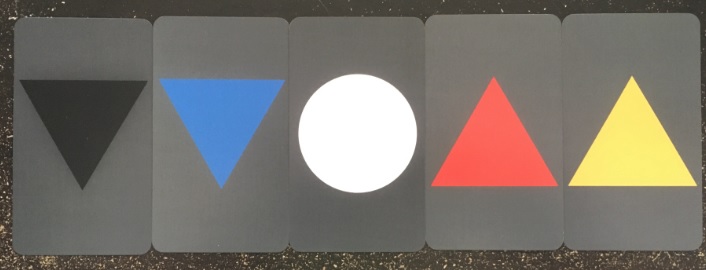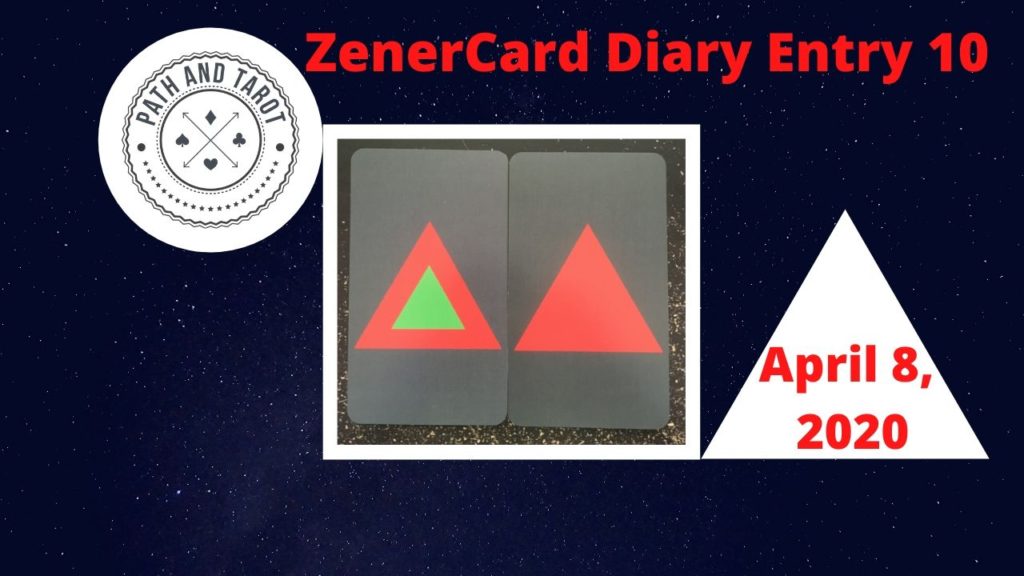Zener Card Diary April 8, 2020.
I am getting to the point in this diary where I have collected enough data to see at a higher resolution.
The next phase of testing will be done with my new elemental cards. I made the cards myself and printed them through Make Playing Cards dot Com.
Elemental Origins
Music is a great example of tracing a path of influence from artist to artist. Find me a piece of music and I will tell you the influence that made that music possible. As such, these cards have their path of influence, and it leads straight to Golden Dawn Magic.
I spent some time with the book Golden Dawn Magic: A Complete Guide to the High Magical Arts by Chic Cicero & Sandra Tabatha Cicero. This text, in particular, was the impetus to create this deck of cards. Pages 300 to 305 is the exact reference source for these cards. Those pages describe the elements, how to form their sub-elements, and how to use them for magical purposes.
I followed these exact steps to create elemental cards as magicians had done before me.
The Cards
The deck (unnamed) is designed after the the five western symbols for the elements.
Spirit, a white circle.
Air, a yellow upright triangle.
Fire, a red upright triangle.
Water, a blue upside-down triangle.
Earth, a black upside-down triangle.

I designed the sub-elements which contain an element within an element for a total of 25 sub-elements. Including the core elements gave me 30 cards.
I made extra copies of the 5 elements. I added 10 copies of each element so that I could make two 25 cards decks. In total it created 80 cards.
The deck can be configured in many different ways. I can divide them into a group of 30 cards and two 25 card decks, or any other configuration I want for psychic testing. If I want to, I can perform the Zener card test can with the familiar deck size of 25.
Elemental Testing
The next series of tests used 25 cards. I practiced more visualization for each guess.
On April 2nd I did two tests on an Instagram live stream. I took my time and made each guess visualizing the answer. The tests took about 10 minutes. In the first test, I got 6 hits out of 25 for a 24% hit percentage. In the next test, I got 3 hits out of 25 for a 12% hit percentage.
Looking back at my results from previous tests with 65 cards I can see that the average range was between 15% and 25% as a hit percentage.
My thought was that if I took more time to visualize that I would get a better score. It seemed that my score was no better than previous sessions.
Live Test
On April 3rd I tested someone else on an Instagram live stream. This test yielded 6 hits out 25 for a 24% hit percentage. This was the same result as my first test on April 2nd.
Despite not seeing anything significant in the hit percentage in either test, something interesting happened in the guesses.
On the first test that I did on myself, I guessed correctly spirit, water, air, air, air, and earth.
The third test where I tested someone else, they had guessed spirit, water, spirit, earth, spirit, and earth as correct answers.
What was notable was that the person guessing never guessed air. For my test, I guessed all the elements at some point in the test. Both guessing schemes achieved the same hits, but in a different way.
Keeping Score
Keeping track of each guess reveals new information. What made the test subject not guess air? Did that guessing method impact the results significantly, or was it by chance that they got the same hit percentage as me?
What I can see now is that regardless of the deck size, myself or someone else can get roughly the same hit percentage.
New Deck Size
At the moment I have the deck configured at 75. I have the core elements in the deck along with 25 sub-elements. The core elements are 10 copies of each of the primary elements earth, air, fire, water, and spirit to make 50.
Next what I can do is attempt to make guesses from a larger deck without using all of the cards. On top of that, I can also make guesses and shuffle the cards after each attempt.
I am not sure what I will do if a sub-element comes up. What I could do is count it as a hit if I guess the primary or subordinate element correctly.
As far as I know, the Zener card test has not been performed with new types of cards. This new addition will be the sub-elements to guess. I feel good about this variation because it increases the odds of getting a higher score. We will see how the new testing will work out.
References:
Special note. In this article is an affiliate link from the Amazon Associates program. This is a link that will take you to the buy page on Amazon. I feel this is a positive connection and will allow anyone interested a chance to investigate the product. As an Amazon Associate I earn from qualifying purchases, and that any gains I receive are reinvested into this website. The end result is you are supporting me. You can do it through buying something you may already want to buy. More on this is available in my Disclaimer. Thank you for your readership and support.
If you so choose, you can see the resources that made this website possible.
Resources
Read the next entry here:
Zener Card Diary Entry 11
Missed the first entry? Start again here:
Zener Card Diary Entry 1

